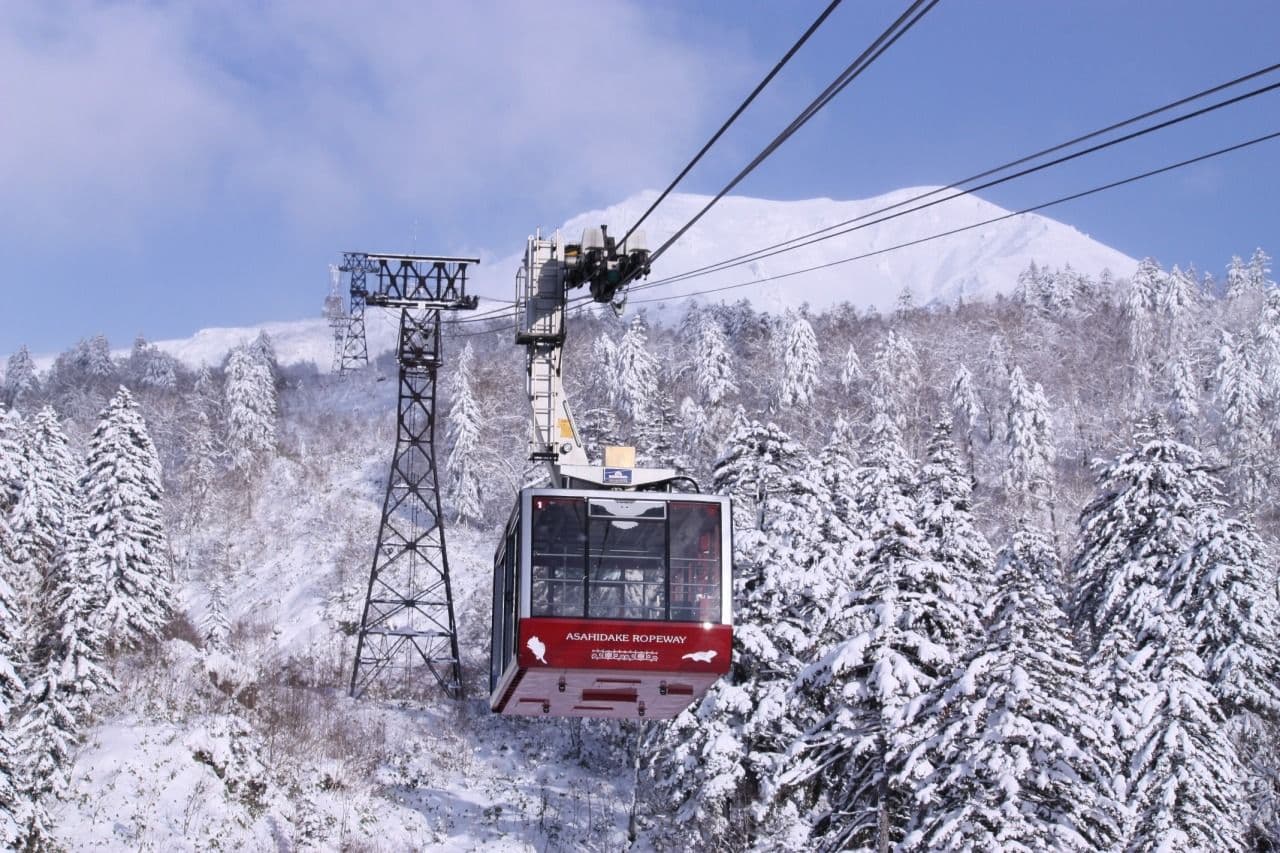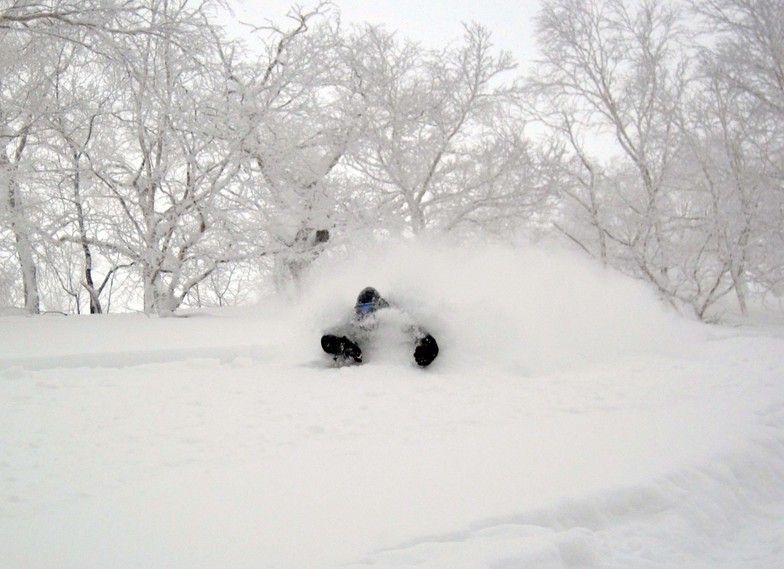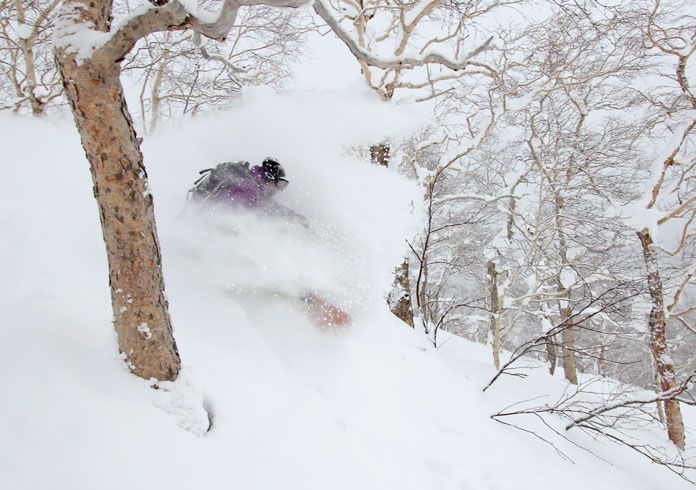Asahidake
Hokkaido’s Untamed Powder Frontier

旭岳
The Call of the Wild
Asahidake isn’t a resort in the conventional sense — it’s Japan’s highest lift-accessed terrain and a shrine to the soul of powder riding. There are no luxury hotels at the base, no après scene pumping until midnight, no parade of ski school kids in matching bibs. Instead, there’s a single ropeway lifting you to the shoulder of an active volcano, steam vents hissing into the cold air, and an endless canvas of untouched snow.
The first time you step off that ropeway at 1,600m, the air feels thinner — not from altitude, but from the sheer stillness of the place. Instead of lift towers cutting across the skyline, you’re met with ridgelines draped in snow and the constant swirl of wind carrying fresh flakes. Your playground stretches as far as your legs, lungs, and avalanche gear will take you.

Unlike the mega-resorts of Hokkaido, Asahidake doesn’t serve up its powder with a side of convenience. This is self-service skiing. There are no marked groomers beyond the short return track to the ropeway. Every run requires reading terrain, picking a safe line, and keeping enough speed to reach the base. It’s liberating — and a little intimidating — the first time you realise that nobody is telling you where to go.
Asahidake draws a particular kind of rider. You’ll see locals with decades-old powder boards, Euro ski mountaineers checking slope angles, and small groups of overseas riders with guides. Everyone is here for the same reason: deep, untracked turns in one of the snowiest places on Earth. If you’re looking for heated gondola seats and a cappuccino bar, you’re in the wrong place. If you dream about face shots in the trees and alpine lines that reset overnight, welcome home.
Resort Stats
- Vertical500m (1600m → 1100m)
- Snowfall~17m
- Terrain 0% 20% 80%
- Tree Riding
- Lift Pass$34
- Lifts1 Ropeway (tram)
- Crowds
- Out of BoundsFully open, but unpatrolled
- Night Skiing
- Family Friendly
- Trails0
- Skiable Area~100ha
- VibeRaw, untamed, backcountry purist
Powder & Terrain
If you measure a resort by how long fresh snow lasts, Asahidake is almost unfair. On storm cycles — which here is just called “Tuesday” — you can find untracked lines days after the snow stops. The ropeway drops you into a high alpine bowl with options that fan out like fingers: steep fall-line chutes, open powder fields, and natural gullies that collect snow like a catcher's mitt.
The top station opens to a short traverse, from which you can drop into wide alpine slopes that roll into trees. The pitch starts steep enough to get your heart racing, then mellows into playful terrain where you can link turns between snow ghosts. These frost-covered trees are more than just beautiful — they shelter the snow from wind, creating silky pockets even in clear weather.

On big storm days, visibility up top can vanish in a heartbeat. That’s when the lower mountain’s tree zones come into their own. The glades are spacious, with a rhythm that lets you flow without constant speed checks. The trick is knowing where to pop out to hit the return track back to the base without a long skate — miss it, and you’ll be breaking trail in waist-deep snow.
For those willing to hike, the options multiply. Short skins open up sidebowls and ridgelines that rarely see traffic. Longer tours can take you towards the summit crater, where the volcano’s steam vents remind you you’re riding on living earth. Just remember: this is avalanche terrain, unmanaged and unpatrolled. Gear, knowledge, and a partner who knows their stuff are mandatory.
The ropeway runs every 20 minutes, and with only one lift, the pace is refreshingly unhurried. You’ll spend more time riding than queueing, and the snow quality stays pristine well into the afternoon. It’s the opposite of the “tracked-out-by-10am” problem — here, powder days linger.
Who's it for?
Asahidake is for riders who want raw, unfiltered Japow. Advanced and expert skiers and snowboarders will thrive here, especially those confident in avalanche terrain. Splitboarders and backcountry skiers will see it as a gateway to endless objectives. Strong intermediates with off-piste experience can enjoy the mellower tree lines, but complete beginners should look elsewhere — there’s no gentle learning zone here.
Accommodation
You won’t find a neon-lit base village here. Instead, Asahidake Onsen, a small hot spring hamlet at the foot of the ropeway, offers a handful of lodges and ryokans. These range from rustic family-run stays with tatami rooms and hearty Hokkaido dinners, to slightly more modern alpine inns with western bedding. Every spot comes with the bonus of soaking in mineral-rich onsen water while snow piles up outside.
For more choice, the nearby town of Higashikawa is just a 30-minute drive down the mountain. It’s a charming base with cafés, bakeries, and a few boutique stays that cater to both skiers and photographers (the Daisetsuzan range is a lens magnet). Here, you can find affordable pensions alongside stylish modern guesthouses with views of the peak.
If you’re after urban comforts or a nightlife hit after days in the backcountry, Asahikawa — Hokkaido’s second-largest city — is about an hour away. It has a broad range of hotels, from budget business options to high-end chains, plus a serious food scene built around its famous miso ramen.
Food & Après
At the base of the ropeway, there’s a simple cafeteria serving Japanese curry, ramen, and coffee — the kind of no-fuss, fuel-up-and-go meals that taste better after 800 vertical metres of powder turns. Some of the onsen lodges also serve meals to non-guests if booked in advance, often featuring local venison, Hokkaido vegetables, and fresh dairy.
Higashikawa has small but excellent dining options, from artisan bakeries perfect for pre-ski snacks to izakayas grilling up yakitori. Asahikawa’s food scene is the big draw: steaming bowls of its signature ramen, fresh seafood flown in from Hokkaido’s coasts, and bars pouring local sake in cozy, low-lit rooms. Après here is less about partying until 2am and more about swapping powder stories over a good drink.
Getting There
The closest airport is Asahikawa Airport, about 45 minutes away by car. From there, you can rent a vehicle — highly recommended for flexibility — or catch a combination of buses and trains, though public transport connections can be infrequent in winter. If you drive, be ready for icy mountain roads and carry snow chains.
From Sapporo’s New Chitose Airport, it’s a 3-4 hour trip by car or rail/bus combo. Many riders build Asahidake into a Hokkaido road trip, linking it with Furano, Kamui, or Tokachidake.
Japow Travel Tips
- Lift Hours: Ropeway runs roughly 9am–4pm, every 20 minutes.
- Avalanche Safety: No patrol-managed avalanche control — carry beacon, shovel, probe, and know how to use them.
- Weather Patterns: Frequent storms and whiteouts; check forecasts before committing to high alpine lines.
- Language: Limited English at the base; more in nearby towns.
- Unique Factor: Skiing on the flanks of an active volcano, with steam vents and a high-alpine setting unlike anywhere else in Japan.
- Nearby Resorts: Furano, Kamui Links, Tokachidake.
Verdict – For the Love of the Deep
Asahidake isn’t for everyone — and that’s exactly why it’s magic. It strips skiing back to its purest form: snow, terrain, and your own decisions. No lift maze, no groomers, no resort frills. Just you, your crew, and the volcano. If you want to trade crowds for silence and carve your own lines through some of the deepest snow on the planet, this is the place.